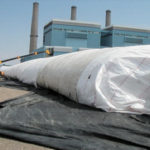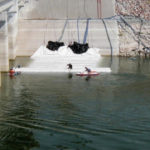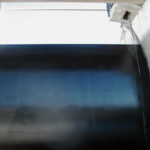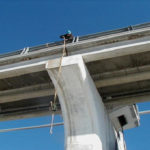
This was a repair of flood gates for a dam that holds back the reservoir for a power company. Hunters had been shooting holes in the steel doors. The bullet holes had rusted the metal, and it needed a new paint job, as well as improving the integrity of the doors.

The job called for an open-ended, 16' high x 350' long, AquaDam. This is a picture of the unloading of the cofferedam components.

The outside material of the AquaDams were laid out on a clean, swept surface. In this case it was a large cement parking area. Tarps were put down first to reduce the abrasiveness of the cement.

The outside tube consisted of three double-ply tubes. This is one of the inside tubes that had already been lined with plastic and was ready for insertion into the outside tube.

Both inside tubes had been inserted and all the components had been put together. The AquaDam is blown up for inspection and for repositioning the various components, basically stretching it from the inside out using air pressure. The Lift-All was extended over the AquaDam to counter any potential wind gusts.

A power line pole was provided by the utility co-op. This was used to roll up the AquaDam.

Notice the ratchet poles on each end assisting the rolling up of the AquaDam. The forklift behind the AquaDam also assisted in the rolling. It was a team effort to get a tight roll.

Tennis shoes were put on the end of the forks of the forklift to prevent puncturing during the rolling process.

The 16' AquaDam (after rolling) is lifted onto truck trailer. It is being transported 7 miles to the reservoir. It took approximately 3 days to assemble the components of the AquaDam.
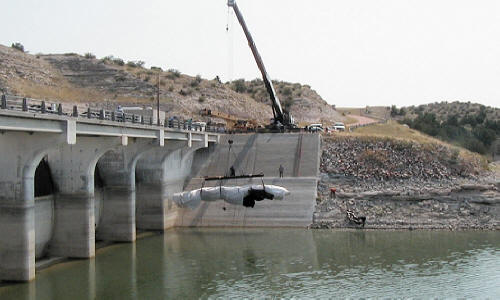
Using a different crane, the AquaDam is lowered into the water. The AquaDam is rolled up on a 50' long power line pole. Another way of getting the AquaDam to this location would have been transporting it on a boat and pulling it through the water, placing it into position. AquaDams float quite easily.

The AquaDam is now ready for inflation. There are many ropes running to the end of the AquaDam where they are tied off to a guard rail. The cement wall has a 4' flat area half way up. The inflation hoses had to go from the pumps at waters edge up to the flat area near the wall (approximately 30').

Water was being pumped into the AquaDam, building pressure, causing it to unroll. The Jet Ski seen here is used to push and pull on the AquaDam to make sure it ends up in the exact location desired. The water depth here is approximately 10'. The AquaDam is sitting on a concrete slab that has at least 1' of mud on it.

It takes a long time for eight 3" pumps to fill up an 16' AquaDam. The water capacity is approximately 350,000 gallons. Inflation can be accomplished in one to two days.
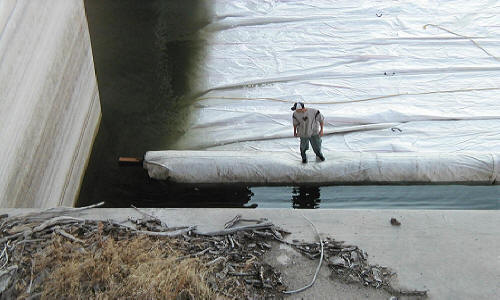
This was abutting the AquaDam into the far side of the concrete face of the wing wall of the dam. The AquaDam will roll right up the wall as the internal head pressure builds.
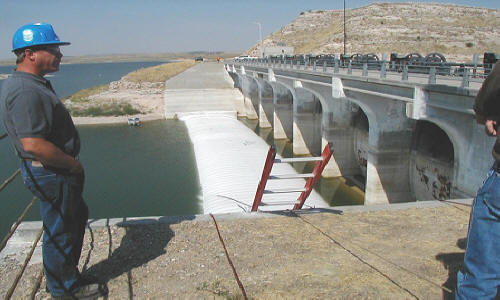
We are now all the way across and have at least a 1' head inside the AquaDam. It is still not finished filling up.

The purpose of the AquaDam is to not allow any water to escape the floods doors while they are open for maintenance and painting. It also prevented any sand-blasted, painted material from leaching into the lake water. The AquaDam� made an ideal platform next to the work area. Notice the two pumps sitting on top of the AquaDam� which were dewatering the work area. The entire work area did not need to be dewatered, but brought down to a level below the opening of the flood gate.
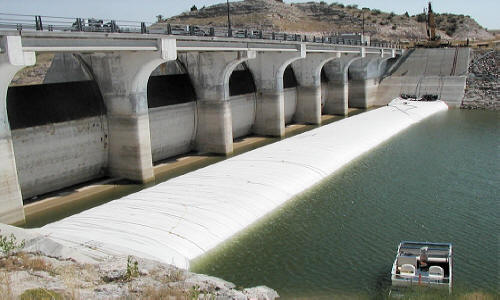
The AquaDam was pushing against the cement columns of the cement dam. There are six doors here that need maintenance and painting.

This shows a view from a spot overlooking the gravel dam that holds back this reservoir. To the right-hand side (not shown) are the flood gates that need to be repaired.

This is a picture of the overflow channel which is critical for the management of high rain events. We are approximately 1/2 mile away.

Standing on top of the AquaDam looking down you can see fish grazing on the algae that is growing on the side of the AquaDam. After being in the water for only 3 months, a great amount of algae was growing on the side of the AquaDam. Fish would line up by the hundreds to feed.
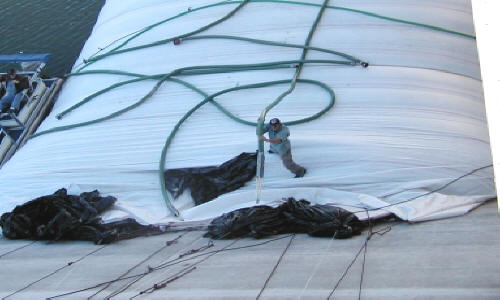
Here we are looking down from the wing walls of the cement dam. Notice all the ropes that had to be used to support the end of the AquaDam so it would not fall down the steep slope.

The work has been completed and it is now time to remove the AquaDam. Standing on the AquaDam we are looking up at the sand-blasted, freshly painted, steel doors.

We removed the objects from the AquaDam by hoisting them up ropes onto the roadway above.

The AquaDam is now deflating and it can not support the weight of a human walking on it without sinking below the top of the lake.

After draining both inside chambers using pumps, each inside tube was taken out. A crane was used to lift the end up to the top of the embankment. The crane reattached to a rope located around the body of the AquaDam tube at the base of the concrete embankment. The crane lifted while the backhoe pulled on the end of the AquaDam so it would not pile up in one spot.

Each of the inside tubes of the AquaDam was removed and rolled up for transportation and later use.

This is the second inside tube being removed. It is pulled off the water molecules that are inside of it.

This is the outside tube being lifted up. Notice that no dirty water is being created.
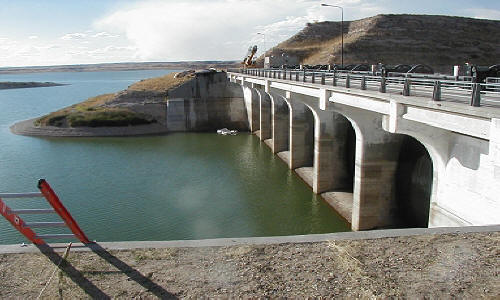
All gone. Job done.




